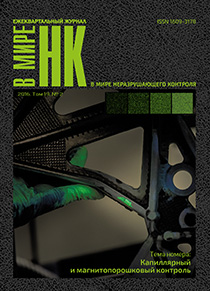Har'kov, Ukraine
Introduction. Specialists of Gvozdev NIIZhB for examination of building structures made of steel pipes successfully use the Measurement of the Coercive Force (MCF) method. At the inspection of pipes with wall thicknesses less than 5 mm abnormally high values of the coercive force (Нс) have been obtained. However, there is no information about Нс dependence on the rolled steel sheet thickness, which is less than 6 mm, in the technical literature. The objective of this work was to study the Нс dependence on rolled low-carbon steel sheets thicknesses (<5 mm). Method. For the experiment, sections of a tube were used as specimens; the required wall thicknesses for each specimen were achieved by lathe work. The technology of pipe manufacturing was taken into account, such as cold moulding of hot-rolled steel; cold moulding of cold-rolled steel; cold moulding of heat-treated rolled low-alloyed steel; heat-treated (annealed) pipe metal after molding. For each specimen we measured Нс in longitudinal and transverse directions relative to the axis of the pipe. Results. Measurements showed significant difference in the values of Нс for the pipes of the same steel grade but with different wall thicknesses, especially for thin-walled pipes (<5 mm). It is revealed that heat treatment (annealing) significantly reduces the Нс dependence on the metal thickness in comparison with the initial state of metal. Conclusion. Wall thickness in the range of 1.5–4 mm significantly affects the value of Нс. When carrying out measurements on thin-walled tubes (<5 mm), it is necessary to take into account the pipe manufacturing technology. Heat treatment (annealing) of the pipes after moulding greatly reduces the influence of the pipe wall thickness on the coercive force value.
coercive force, pipe, wall thickness, heat treatment, annealing, steel, rolled steel
1. Bogacheva N. D. V mire NK [NDT World]. 2005, no. 2(28), pp. 8-10 (in Russ.).
2. Nichiporuk A. P., Stashkov A. N., Kostin V. N. et al. V mire NK [NDT World]. 2015, vol. 18, no. 4, pp. 9-13 (in Russ.).
3. Matyuk V. F., Kulagin V. N. Nerazrushayushchiy kontrol´ i diagnostika [Non-Destructive Testing and Diagnostics, ISSN 2224-1752, Belarus]. 2010, no. 3, pp. 4-14 (in Russ.).
4. STO 36554501-040-2014. Diagnostika stal´nykh stroitel´nykh konstruktsiy. Metod magnitnyy, koertsitimetricheskiy [Diagnostics of construction steelworks. Magnetic coercimetric method]. Stroitel´stvo, Moscow, 2014.
5. Popov V. A., Gudoshnik V. A., Khorlo N. F. [About some problems of stress-strain state monitoring of hoisting equipment metal structures with the use of magnetic structural analysis]. Sobytiya v mire diagnostiki i ekspertiz [Society of Technical Supervision “Diex”] (in Russ.). Available at: http://en.tuev-dieks.com/press-center/articles/sobyitiya-v-mire-diagnostiki-i-ekspertiz/o-nekotoryix-problemax-monitoringa-napryazhenno-deformirovannogo-sostoyaniya-metallokonstrukczij-podemnyix/ (accessed on 02.06.2016).
6. Arefyev Yu. V., Shalygo A. A. V mire NK [NDT World]. 2016, vol. 19, no. 1, pp. 44-48 (in Russ.).





